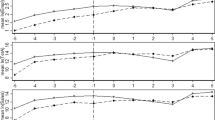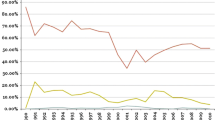Abstract
Government-sponsored venture capital (GVC) has been used to support financially constrained start-ups as an important policy tool in China. Typically, to motivate the social capital to invest in start-ups, GVC provides subsidies for them to bridge the funding gap in the early-stage venture capital market. However, the effect and mechanism of GVC affecting social capital investment have not been clearly studied. In this paper, the authors not only develop a game model to analyze this issue in theory, but conduct an empirical study by analyzing the 14741 records matched by propensity score matching (PSM) of Chinese venture capital market data from 2011 to 2021. The proposed findings are as the follows. Firstly, the subsidies offered by GVC will simultaneously increase the returns and risks of investments in start-ups of social capital with more volatile incentive effect of GVC. The incentive effect of GVC is only effective when the returns resulting from the subsidies outweigh the risks they introduce. In the context of the Chinese venture capital market, the incentive effect of GVC is effective. Secondly, the incentive effect of GVC is more pronounced in high-tech industries, which can be attributed to the signaling effect facilitated by GVC. In this context, the subsidy mainly helps social capital to bear the costs associated with screening potential investments. Thirdly, the incentive effect of GVC is more significant in underdeveloped venture capital markets, which can be explained by the “virtuous cycle” effect, in which GVC plays a pioneering role in establishing a more robust early-stage market trading system. By examining these three points, this study contributes to a better understanding of how GVC can effectively guide social capital investment, especially in the Chinese landscape.
Similar content being viewed by others
References
Suchard J A, Humphery-Jenner M, and Cao X, Government ownership and venture capital in China, Journal of Banking & Finance, 2021, 129: 106164.
Akcigit U and Kerr W R, Growth through heterogeneous innovations, Journal of Political Economy, 2018, 126(4): 1374–1443.
Carpenter R E and Petersen B C, Capital market imperfections, high-tech investment, and new equity financing, The Economic Journal, 2002, 112(477): F54–F72.
Gorman M and Sahlman W A, What do venture capitalists do?, Journal of Business Venturing, 1989, 4(4): 231–248.
Jeng L A and Wells P C, The determinants of venture capital funding: Evidence across countries, Journal of Corporate Finance, 2000, 6(3): 241–289.
Denis D J, Entrepreneurial finance: An overview of the issues and evidence, Journal of Corporate Finance, 2004, 10(2): 301–326.
Cumming D, Fleming G, and Suchard J A, Venture capitalist value-added activities, fundraising and drawdowns, Journal of Banking & Finance, 2005, 29(2): 295–331.
Chemmanur T J, Loutskina E, and Tian X, Corporate venture capital, value creation, and innovation, The Review of Financial Studies, 2014, 27(8): 2434–2473.
Lerner J and Nanda R, Venture capital’s role in financing innovation: What we know and how much we still need to learn, Journal of Economic Perspectives, 2020, 34(3): 237–261.
Zider B, How venture capital works, Harvard Business Review, 1998, 76(6): 131–139.
Lu H, Tan Y, and Huang H, Why do venture capital firms exist: An institution-based rent-seeking perspective and Chinese evidence, Asia Pacific Journal of Management, 2013, 30: 921–936.
Hall B H, The financing of research and development, Oxford Review of Economic Policy, 2002, 18(1): 35–51.
Colombo M G, Cumming D J, and Vismara S, Governmental venture capital for innovative young firms, The Journal of Technology Transfer, 2016, 41: 10–24.
Pruthi S, Wright M, and Lockett A, Do foreign and domestic venture capital firms differ in their monitoring of investees?, Asia Pacific Journal of Management, 2003, 20: 175–204.
Sapienza H J, Manigart S, and Vermeir W, Venture capitalist governance and value added in four countries, Journal of Business Venturing, 1996, 11(6): 439–469.
Kaplan S N and Stromberg P E R, Characteristics, contracts, and actions: Evidence from venture capitalist analyses, The Journal of Finance, 2004, 59(5): 2177–2210.
Busenitz L W, Fiet J O, and Moesel D D, Reconsidering the venture capitalists’ “value added” proposition: An interorganizational learning perspective, Journal of Business Venturing, 2004, 19(6): 787–807.
Guerini M and Quas A, Governmental venture capital in Europe: Screening and certification, Journal of Business Venturing, 2016, 31(2): 175–195.
Griliches Z, The search for R&D spillovers, Scandinavian Journal of Economics, 1992, 94: 29–47.
Yang X, Tian K, Zhu L, et al., Government investment and high-quality economic development measurement and analysis based on input-output method, Journal of Systems Science & Complexity, 2022, 35(3): 993–1008.
Brander J A, Du Q, and Hellmann T, The effects of government-sponsored venture capital: International evidence, Review of Finance, 2015, 19(2): 571–618.
Bertoni F and Tykvov T, Does governmental venture capital spur invention and innovation? Evidence from young European biotech companies, Research Policy, 2015, 44(4): 925–935.
Bertoni F, Colombo M G, and Quas A, The role of governmental venture capital in the venture capital ecosystem: An organizational ecology perspective, Entrepreneurship Theory and Practice, 2019, 43(3): 611–628.
Meng W D, Wang L M, and Xiong W Q, Compensation mechanism for public capital to private capital in entrepreneurship fund of funds, Systems Engineering — Theory & Practice, 2010, 30(9): 1572–1578.
Xiong W Q, Government’s compensation mechanisms and their incentive effects under FOF institution, Systems Engineering — Theory & Practice, 2013, 33(8): 1926–1933.
Khanna T and Palepu K G, Winning in Emerging Markets: A Road Map for Strategy and Execution, Harvard Business Press, Cambridge, 2010.
Leleux B and Surlemont B, Public versus private venture capital: seeding or crowding out? A pan-European analysis, Journal of Business Venturing, 2003, 18(1): 81–104.
Armour J and Cumming D, The legislative road to silicon valley, Oxford Economic Papers, 2006, 58(4): 596–635.
Huang Z and Tian X, China’s venture capital market in ‘The Handbook on China’s Financial System’, PBCSF-NIFR Research Paper, 2019, DOI: https://doi.org/10.2139/ssrn.3423553.
Dushnitsky G and Yu L, Why do incumbents fund startups? A study of the antecedents of corporate venture capital in China, Research Policy, 2022, 51(3): 104463.
Yang Q, Huang Y S, Guo F, et al., Does public policy towards venture capital promote local innovation? Evidence from China’s establishment of fund town, Finance Research Letters, 2023, 52: 103578.
Chen J, Venture capital research in China: Data and institutional details, Journal of Corporate Finance, 2022, 81: 102239.
Lerner J, When bureaucrats meet entrepreneurs: The design of effective ‘public venture capital’ programmes, The Economic Journal, 2002, 112(477): F73–F84.
Bayar O, Chemmanur T J, and Liu M H, How to motivate fundamental innovation: Optimal interactions between entrepreneurs, venture capitalists, and the government, Venture Capitalists, and the Government, 2019, DOI: https://doi.org/10.2139/ssrn.2799490.
Lerner J, Boulevard of Broken Dreams, Princeton University Press, Princeton, 2009.
Lerner J, The future of public efforts to boost entrepreneurship and venture capital, Small Business Economics, 2010, 35(3): 255–264.
Faccio M, Politically connected firms, American Economic Review, 2006, 96(1): 369–386.
Li H, Meng L, Wang Q, et al., Political connections, financing and firm performance: Evidence from Chinese private firms, Journal of Development Economics, 2008, 87(2): 283–299.
Marti J and Quas A, A beacon in the night: Government certification of SMEs towards banks, Small Business Economics, 2018, 50: 397–413.
Chen Y, Liu M, and Su J, Greasing the wheels of bank lending: Evidence from private firms in China, Journal of Banking & Finance, 2013, 37(7): 2533–2545.
Batjargal B A T, Hitt M A, Tsui A S, et al., Institutional polycentrism, entrepreneurs’ social networks, and new venture growth, Academy of Management Journal, 2013, 56(4): 1024–1049.
Zhang R, Yang X, Li N, et al., Herd behavior in venture capital market: Evidence from China, Mathematics, 2021, 9(13): 1509–1527.
Huang R H, The regulation of securities offerings in China: Reconsidering the merit review element in light of the global financial crisis, Hong Kong Law Journal, 2011, 41: 261–283.
He X and Su Y, Do the “haves” come out ahead in Shanghai courts?, Journal of Empirical Legal Studies, 2013, 10(1): 120–145.
Li J, Government as an equity investor: Evidence from Chinese government venture capital through cycles, SSRN Electronic Journal, 2022, DOI: https://doi.org/10.2139/ssrn.4221937.
Hall B H and Lerner J, The financing of R&D and innovation, Handbook of the Economics of Innovation, North-Holland, 2010, 1: 609–639.
Teece D J, Profiting from technological innovation: Implications for integration, collaboration, licensing and public policy, Research Policy, 1986, 15(6): 285–305.
Junkunc M T and Eckhardt J T, Technical specialized knowledge and secondary shares in initial public offerings, Management Science, 2009, 55(10): 1670–1687.
Walker G, Kogut B, and Shan W, Social capital, structural holes and the formation of an industry network, Organization Science, 1997, 8(2): 109–125.
Rosenbaum P R and Rubin D B, The central role of the propensity score in observational studies for causal effects, Biometrika, 1983, 70(1): 41–55.
Li S M, Liang X Y, and Wang D Z, The guiding effect and mechanism of governmental guidance funds in China, South China Journal of Economics, 2020, (8): 1–16.
Binks M R, Ennew C T, and Reed G V, Information asymmetries and the provision of finance to small firms, International Small Business Journal, 1992, 11(1): 35–46.
Lerner J, The government as venture capitalist: The long-run impact of the SBIR program, The Journal of Private Equity, 2000, 3(2): 55–78.
Author information
Authors and Affiliations
Corresponding author
Ethics declarations
The authors declare no conflict of interest.
Additional information
This research was supported by the National Natural Science Foundation of China under Grant No. 71991474 and the Natural Science Foundation of Guangdong Province under Grant No. 2022A1515011893.
Rights and permissions
About this article
Cite this article
Ni, X., Zheng, T., Gao, F. et al. Stimulating Start-up Investment Through Government-Sponsored Venture Capital: Theory and Chinese Evidence. J Syst Sci Complex (2024). https://doi.org/10.1007/s11424-024-3282-1
Received:
Revised:
Published:
DOI: https://doi.org/10.1007/s11424-024-3282-1




